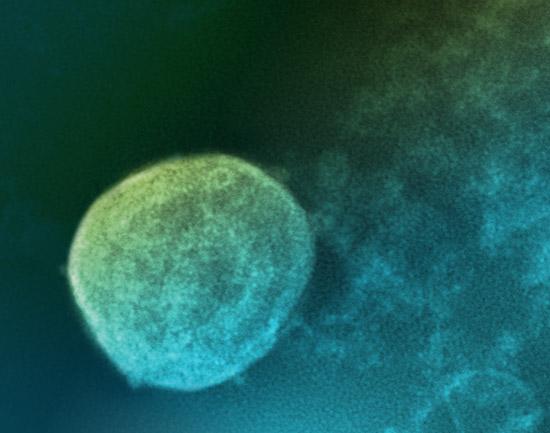A recent NIAID study showed that a vaccine using the same platform being tested in volunteers in West Africa against Ebola virus also protects African green monkeys exposed to Nipah virus a month after a single vaccination. The vaccine uses vesicular stomatitis virus (VSV) as a vehicle to transport immune-generating components of various pathogens—in this study Nipah virus—into a host to generate an immune response. VSV, an animal virus that primarily affects cattle, has been successfully tested as an experimental vaccine platform against several viruses.
Background
Nipah virus first was identified in 1998 when an outbreak in Malaysia and Singapore sickened more than 250 people. To date, there have been more than 500 cases with nearly 300 deaths throughout parts of Southeast Asia.
The virus targets the lungs and causes brain swelling. While infection is rare, the disease is fatal from 40 to 75 percent of the time. Those who survive often experience chronic brain damage. Bangladesh is an example of a region where Nipah virus is a great concern: The nation has experienced outbreaks almost every year since 2001. In 2013, Bangladesh reported 24 Nipah cases that resulted in 21 deaths. In the first two months of 2014, Bangladesh reported 27 cases with 14 deaths; so far in 2015 the nation has documented nine cases with six deaths. Malaysia, Singapore, and India also have reported cases.
There is no treatment for Nipah, although in addition to the VSV vaccine at least three other promising preventive vaccine approaches are being studied.
Fruit bats are the suspected carrier of Nipah virus. Although cases of human-to-human Nipah virus transmission exist, scientists believe the main transmission route is from bats to humans; infected bats contaminate the sweet sap that people consume from date palm trees.
Study Results
Scientists at the NIAID Rocky Mountain Laboratories (RML) inoculated three African green monkeys with the experimental Nipah vaccine, and then 29 days later infected them and three unvaccinated control animals with Nipah virus. They then observed the animals for 17 days; the three control animals developed disease three to five days later. Various samples from those animals showed they were shedding virus in their urine and mucus, and their tissues showed evidence of disease.
The vaccinated animals remained healthy throughout the experiment, and scientists found no evidence of virus in their samples. Further, 14 days after vaccination—more than two weeks prior to being exposed to the virus—the vaccinated animals had developed Nipah-specific antibodies.
The research group had previously completed a similar study successfully using hamsters.
Significance
The scientists believe their vaccine would be advantageous in a Nipah virus outbreak because of the single-dose efficacy and rapid immune response. Cases of human-to-human transmission of Nipah virus have occurred weeks after contact with an infected person, and the virus can survive in an infected host for many months without causing disease.
Next Steps
Based on successful VSV experiments against other viruses, the researchers want to test the Nipah vaccine for post-exposure efficacy; that would tell them whether the vaccine could be used in an emergency setting.
Reference
Prescott J et al. Single-dose live-attenuated vesicular stomatitis virus-based vaccine protects African green monkeys from Nipah virus disease. Vaccine DOI:

A Nipah virus particle budding from a cell used to grow viruses.
10.1016/j.vaccine.2015.03.089 (2015).

